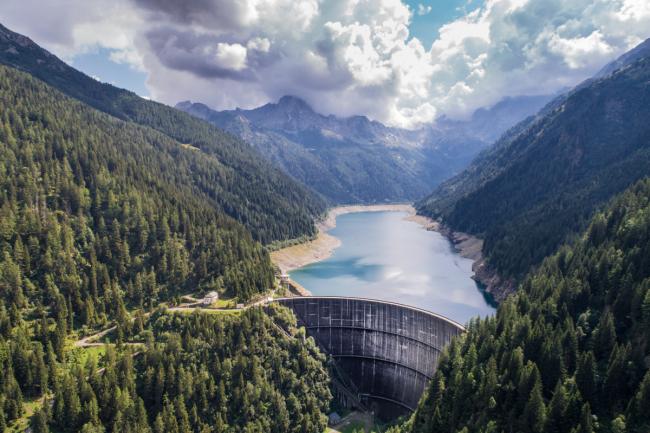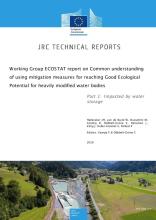Why water storage?
Water is essential for our society. However, water availability is not always synchronized with our needs. Since the distribution of water in time and space is uneven, it is necessary to have water storage systems in place. Water storage systems store excess water, for example during floods, wet periods or when water need is lower than water availability, and release it during dry periods, or when water demand surpasses natural water availability, ensuring a steady supply of water for various uses. Natural water storage systems are represented mainly by lakes and groundwater, but are not always available, or can be exploited only to a certain extent. Therefore, additional artificial water storage needs to be put in place.
Artificial water storage in a European Union’s perspective
Artificial dams retain water, by creating a reservoir or artificial lake, to serve multiple needs including agriculture and electricity generation (hydropower), water supply for industrial and domestic uses, and flood control, or a combination of these. The management of water storage systems requires careful coordination and trade-offs among different uses and targets, particularly in the face of climate change. As the world adapts to the challenges posed by climate change, water storage systems are expected to play an increasingly important role in ensuring integrated water management and providing essential services to society. In the context of a Water Resilient Europe, water storage systems will be crucial in supporting the well-being of both the environment and human populations.

However, water reservoirs connected to rivers, especially when they are of large dimensions, can also cause environmental impacts, such as the interruption of the longitudinal connectivity of the river, with consequent biological, hydrological and morphological impacts. Hydromorphological alterations, due to, for example, water storage, can have major impacts on the aquatic ecology and are among the most widespread pressures on water bodies in Europe. Land use change may also cause social impacts. People reallocation may also be a problem in certain contexts, especially when very large projects are implemented, which is rarely the case of the European Union. Therefore, water reservoirs should be managed with a Water-Energy-Food (Society)-Ecosystem (WEFE) nexus approach. They, and all their interactions with the Earth’s spheres, are the subject of policies falling in the WEFE nexus realm, such as agricultural, energy and water policies.
Dams, and the associated reservoirs, can vary in size, from very small to very large. Large dams are defined as those that are higher than 15 meters, or above 5 meters and have a storage volume of more than 3 million cubic meters, according to the International Commission on Large Dams ( ICOLD, 2023 ). They generally interrupt a river and modulate the flow released downstream. There are approximately 4500 large dams in the EU, which store 290 billion cubic meters of water.

A water reservoir can be conceived for a specific single use (e.g., hydropower, or irrigation), or for multiple uses (e.g., hydropower and flood control, agriculture and water supply). Following plots show the purpose of large dams in the EU, according to the data of ICOLD (2023).
Number of large dams for different uses and water stored in the associated reservoirs, according to ICOLD 2023
Use of the large dams according to ICOLD 2023
Complex and controversial debates
Being of cross-sectoral interest, water reservoirs and large dams are complex topics, generally victim of conflictual and heated debates, especially from society. Some of these discussions have arisen in Spain after the Valencia flood in 2024, and in France, where retention basins have been planned for agricultural purposes.
However, generally speaking and with no specific link with the two previous examples, several of these debates often lack technical and scientific content and the conclusions they draw may be misleading and biased.
For example, some debates focus on the importance of dams in water scarce regions, which may not be always true, as other types of measures (e.g., water and wastewater reuse, water saving) may be more effective in some contexts. Other debates instead complain against dams and promote their removal, without a technical understanding of their important role in water supply, water storage in light of climate changes, hydropower supply for a resilient and flexible energy system and flood mitigation.
However, the effectiveness of dams in mitigating floods also depends on the flood intensity. Some debates accuse water reservoirs to be responsible of water losses due to evaporation, but do not consider the role they may have in groundwater recharge. The benefits and impacts of reservoirs have to be adequately and holistically acknowledged and considered, with a technical and scientific approach that takes into account all aspects of the WEFE nexus, and beyond.
The JRC critical and independent contribution to the debate
To promote a more informed discussion, the Joint Research Centre (JRC) has recently published several studies on water reservoirs and large dams. These publications aim to provide a more nuanced understanding of the complex issues surrounding water reservoirs and their management.
Did you know that water reservoirs store a huge amount of energy (in the form of potential energy of water used by hydropower systems), and are the main contributor in terms of energy storage and energy flexibility of the European Union's energy system? And did you know that some sustainable strategies to increase their water&energy storage are also possible (e.g., using abandoned mines, or increasing the volume of reservoirs by increasing the height of the dams)?
Did you know than one of the largest problems of reservoirs is sediment management and the filling of the reservoir with sediments, and that removing sediments can cost several billion euros per year?
Did you know that, in the era of digital transition, digital solutions and real-time control can also improve the environmental performance of reservoirs and hydropower systems, by mitigating their impacts, and not only enhancing energy generation and security?
Did you know that by retrofitting the existing hydropower fleet, it is possible to increase energy generation without using more water?
Did you know that water reservoirs can host floating photovoltaics, which reduce water evaporation and make available area for renewable energy production?
Did you know that European rivers are highly fragmented? Around 450,000 barriers have been identified in European Union's rivers. Explore the AMBER Atlas to learn more!
Did you know that water storage are also responsible of several impacts that can significantly affect the ecological status of rivers?


